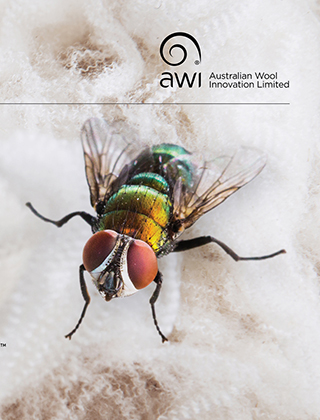Breech strike and body strike breeding values

Can genomics and a Merino reference flock increase the rate of genetic gain in breeding for breech and body strike resistance and profitability? So far, the answer is yes, but more R&D is required and how best to fund an ongoing industry genomics reference flock for all traits needs to be confirmed.
AWI with the Animal Genetics Breeding Unit (AGBU) is investigating flystrike and DNA results from R&D flocks and private flocks to first produce ‘within flock’ breech and body strike breeding values and then ‘across flock’ multi trait Australian Sheep Breeding Values (ASBVs) in the next few years.
The first within flock breeding values for breech and body strike were produced for Grant and Annette Burbidge early this year and the first across flock breech strike values were presented at the New England Merino Lifetime Productivity (MLP) Field Day in May.
While breech wrinkle and dag are correlated with flystrike, some more wrinkly and daggy sheep don’t get struck and some low wrinkle and low dag sheep do. So, while these indirect indicator traits are good indicators, greater accuracy is invariably gained by directly measuring the trait itself. This increases the rate of genetic gain.
Secondly, by directly measuring the trait, it is likely to mean that breech wrinkle and dag will not need to be reduced as much. The target of all sheep being 2 score or less for breech wrinkle and dag may be able to increase to say 2.5 score, and the same is likely to apply to body strike. This will assist Merino types that are naturally more susceptible to breech and body strike.
Breech strike and body strike are hard to measure traits and prime candidates for assistance from the ever-expanding benefits of using genomic selection. Genomics improves the impact of pedigree relationships (from close and distant relatives) and the influence of known associations between a genotype and the expression of the trait, in this case breech and body strike. A genomics reference flock will be required for breech and body strike so that animals without a direct measure can gain a valuable predictive breeding value.
Burbidge Farms, Tarcutta

Dr Elena Dehnavi of AGBU with Grant and Annette Burbidge of Burbidge Farms, Tarcutta, at the New England MLP Field Day in May 2024.
Grant and Annette Burbidge run 28,000 fine wool sheep in 800 to 900 mm rainfall country at Tarcutta in southern NSW. They breed their own rams within their ‘Connemara Stud’ with an Adult Fibre Diameter (FD) ASBV of -3.6 and Adult Clean Fleece Weight (CFW) ASBV of +10%.
Grant and Annette are keen to push the productivity and welfare credentials further but have been disappointed at the higher flystrike risk in some of the progeny of introduced AI sires in their country and management regime.
“Since the 2017 drop we have collected breech and body strike phenotypes along with struck and non-struck genotypes in the ram breeding flock. Young sheep are crutched at normal times, chemical preventative treatments are not used, but the sheep are intensively inspected, recorded and treated during the risk periods,” Grant said.
“We have now recorded over 700 breech and body strike phenotypes and 2,300 50K DNA genotypes.”
Dr Elena Dehnavi of AGBU with the support of Professors Daniel Brown and Andrew Swan created within flock breeding values for their 2022 drop animals ahead of ewe and sire selection for the 2024 drop joining. Grant and Annette were impressed with the results.
“Obviously any struck progeny had high risk breeding values but what interested us the most were the range of breeding values in the unstruck animals,” Grant said.
“We are happy to share our data and results with the information from the old and new R&D flocks, to create the across flock breeding values that will become available to all ram breeders to help improve animal welfare and profitability.
“Thanks also to Dr Julius van der Werf and UNE who have provided valuable assistance to our work.”
CSIRO New England MLP Flock, Uralla
Dr Jen Smith and the staff at the CSIRO Chiswick Research Station have collected strike phenotypes and genotypes in the AWI Breeding for Breech Strike Resistance Flock and MLP New England Flock.
“AGBU produced across flock research breeding values (RBV) for breech strike for the MLP Field Day but the body strike incidence for the sires had been too low to release a Body Strike RBV,” she said. “Genomics offers some real advantages for welfare traits; a lot of data is needed but I think it could become a great option for ram breeders in the future.”
Other industry pilot flocks
Twelve ram breeder flocks and five Merino Sire Evaluation sites have commenced collecting flystrike phenotypes and genotypes (although some have had low expression over the recent fly season), and other interested producers will join in once within flocks breeding values can be reported back to them next year. The aim, depending on sufficient data, is to release ASBVs in 2027. Ben Swain from BCS Agribusiness is coordinating the data collection from industry flocks and can be contact via email ben.swain@bcsagribusiness.com.au or phone 0427 100 542.
This article appeared in the September 2024 edition of AWI’s Beyond the Bale magazine. Reproduction of the article is encouraged.













